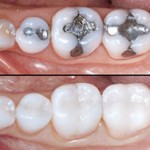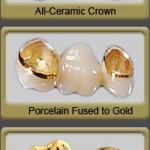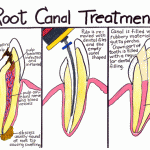Treatment for tooth decay varies according to how severe the decay is.
- Brushing and flossing with fluoride toothpaste and/or receiving fluoride treatments may be enough to reverse early decay, before cavities have formed.
- You need a filling if a cavity has formed. A filling is a material that plugs the cavity hole and restores a tooth to its original shape after your dentist has removed the decay.
Today, several dental filling materials are available. Teeth can be filled with gold; porcelain; silver amalgam (which consists of mercury mixed with silver, tin, zinc, and copper); or tooth-colored, plastic and glass materials called composite resin fillings. The location and extent of the decay, cost of filling material, patients’ insurance coverage, and your dentist’s recommendation assist in determining the type of filling that will best address your needs.
There are two types of indirect fillings – inlays and onlays.
- Inlays are similar to fillings but the entire work lies within the cusps (bumps) on the chewing surface of the tooth.
- Onlays are more extensive than inlays, covering one or more cusps. Onlays are sometimes called partial crowns.
Inlays and onlays are more durable and last much longer than traditional fillings – up to 30 years. They can be made of tooth-colored composite resin, porcelain, or gold. Inlays and onlays weaken the tooth structure, but do so to a much lower extent than traditional fillings.
- You may need a crown if the decay is severe and your tooth is badly damaged. A crown (often called a cap) is a man-made replacement for all or part of a tooth. Crowns are also used to treat teeth that have broken or decayed so much that a filling will not work.
Permanent crowns can be made from all metal, porcelain-fused-to-metal, all resin, or all ceramic.
- Metals used in crowns include gold alloy, other alloys (for example, palladium) or a base-metal alloy (for example, nickel or chromium). Compared with other crown types, less tooth structure needs to be removed with metal crowns, and tooth wear to opposing teeth is kept to a minimum. Metal crowns withstand biting and chewing forces well and probably last the longest in terms of wear down. Also, metal crowns rarely chip or break. The metallic color is the main drawback. Metal crowns are a good choice for out-of-sight molars.
- Porcelain-fused-to-metal dental crowns can be color matched to your adjacent teeth (unlike the metallic crowns). However, more wearing to the opposing teeth occurs with this crown type compared with metal or resin crowns. The crown’s porcelain portion can also chip or break off. Next to all-ceramic crowns, porcelain-fused-to-metal crowns look most like normal teeth. However, sometimes the metal underlying the crown’s porcelain can show through as a dark line, especially at the gum line and even more so if your gums recede. These crowns can be a good choice for front or back teeth.
- All-resin dental crowns are less expensive than other crown types. However, they wear down over time and are more prone to fractures than porcelain-fused-to-metal crowns.
- All-ceramic or all-porcelain dental crowns provide the best natural color match than any other crown type and may be more suitable for people with metal allergies. However, they are not as strong as porcelain-fused-to-metal crowns and they wear down opposing teeth a little more than metal or resin crowns. All-ceramic crowns are a good choice for front teeth.
- You may need a root canal treatment if the pulp of your tooth is infected. A root canal removes the diseased pulp of a tooth.
An access hole will be drilled into the tooth. The pulp along with bacteria, the decayed nerve tissue and related debris is removed from the tooth. Once the tooth is thoroughly cleaned, it is sealed. Some dentists like to wait a week before sealing the tooth. For instance, if there is an infection, your dentist may put a medication inside the tooth to clear it up. Others may choose to seal the tooth the same day it is cleaned out.
- You may need your tooth taken out (extraction) if the root of the tooth is severely damaged. You may need to replace the tooth with a bridge or an implant.
If you do not treat tooth decay, your cavities can get worse and you may lose a tooth. If you wait to see your dentist, your tooth repair will probably cost more and take longer.
What To Think About
Many people are very nervous before or during a dental visit. This can make going to the dentist a difficult experience. You can take steps to limit your anxiety, such as explaining your fears to the dentist and setting up a system of hand signals. Hand signals let you tell the dentist when something hurts or you want a break, even if you cannot talk.


